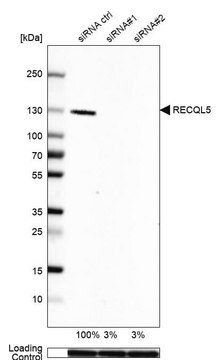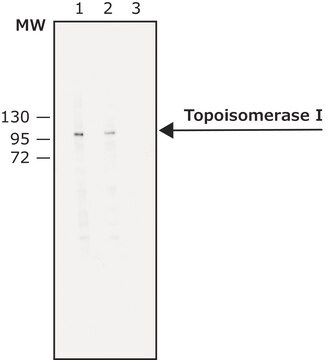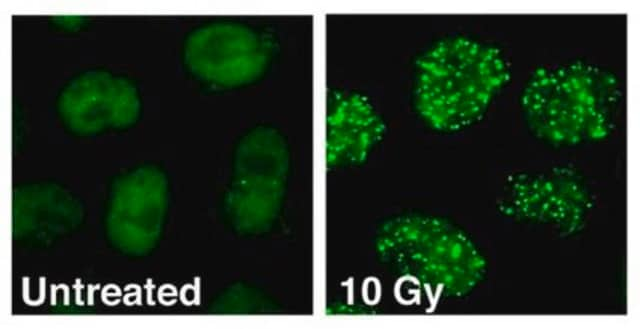MABE1084
Anti-Topoisomerase I-DNA Covalent Complexes Antibody, clone 1.1A
clone 1.1A, from mouse
Synonym(e):
Topoisomerase I-DNA covalent complex, DNA topoisomerase 1-DNA covalent complex, Topo I-DNA covalent complex, TopoI cc, TopoIcc
About This Item
Empfohlene Produkte
Biologische Quelle
mouse
Qualitätsniveau
Antikörperform
purified antibody
Antikörper-Produkttyp
primary antibodies
Klon
1.1A, monoclonal
Speziesreaktivität
human, mouse
Methode(n)
ELISA: suitable
dot blot: suitable
flow cytometry: suitable
immunocytochemistry: suitable
Isotyp
IgG2bκ
NCBI-Hinterlegungsnummer
UniProt-Hinterlegungsnummer
Versandbedingung
wet ice
Posttranslationale Modifikation Target
unmodified
Angaben zum Gen
human ... TOP1(7150)
Allgemeine Beschreibung
Spezifität
Immunogen
Anwendung
Epigenetik & nukleäre Funktionen
Chromatin-Biologie (ChIP)
Immunocytochemistry Analysis: 10 µg/mL from a representative lot detected topoisomerase I/DNA covalent complexes in Topotecan-treated A549 human lung carcinoma cells (Courtesy of Dr. Scott H. Kaufmann, Mayo Clinic, Rochester, MN).
Flow Cytometry Analysis: 10 µg/mL from a representative lot detected topoisomerase I/DNA covalent complexes in Topotecan-treated HCT116 human colon cancer cells (Courtesy of Dr. Scott H. Kaufmann, Mayo Clinic, Rochester, MN).
Dot Blot Analysis: A representative lot detected the Topotecan-/TPT-stablized topoisomerase I/DNA covalent complexes, but not free topoisomerase I (non-DNA complexed) by slot blot using CsCl2 gradient-fractionated lysates from TPT-treated and untreated A549 cells (Patel, A.G., et al, (2016). 44(6):2816-2826).
Dot Blot Analysis: A representative lot detected a Topotecan (TPT) dose-dependent increase of TPT-stabilized topoisomerase I/DNA covalent complexes in lysates from TPT-treated A549 and HCT116 cells by slot blot (Patel, A.G., et al, (2016). 44(6):2816-2826).
Dot Blot Analysis: A representative lot detected stabilized topoisomerase I/DNA covalent complexes in lysates from A549 cells treated with Camptothecins (CPT, SN-38, TPT) or Indenoisoquinolines (NSC 314622, NSC 725776, NSC 743400), but not nucleoside analogues (cytarabine and gemcitabine) (Patel, A.G., et al, (2016). 44(6):2816-2826).
ELISA Analysis: A representative lot detected the immunogen peptide corresponding to topoisomerase I active site sequence with phosphorylated Tyr723, but not the peptide with non-phosphorylated Tyr273 by direct (non-sandwich) ELISA (Patel, A.G., et al, (2016). 44(6):2816-2826).
Immunocytochemistry Analysis: A representative lot detected a dose-dependent increase of non-nucleolar topoisomerase I/DNA covalent complex loci in Topotecan-/TPT-treated A549 cells, while the small number of loci in untreated cells were seen only in nucleoli (Patel, A.G., et al, (2016). 44(6):2816-2826).
Immunocytochemistry Analysis: A representative lot detected a temporally and spatially distinct nuclear loci formation of topoisomerase I/DNA covalent complexes from those of phospho-H2AX and Rad51 in Topotecan-/TPT-treated A549 cells (Patel, A.G., et al, (2016). 44(6):2816-2826).
Qualität
Immunocytochemistry Analysis: 10 µg/mL of this antibody detected topoisomerase I/DNA covalent complexes in Topotecan-treated A549 human lung carcinoma cells.
Zielbeschreibung
Physikalische Form
Lagerung und Haltbarkeit
Sonstige Hinweise
Haftungsausschluss
Sie haben nicht das passende Produkt gefunden?
Probieren Sie unser Produkt-Auswahlhilfe. aus.
Lagerklassenschlüssel
12 - Non Combustible Liquids
WGK
WGK 1
Flammpunkt (°F)
Not applicable
Flammpunkt (°C)
Not applicable
Analysenzertifikate (COA)
Suchen Sie nach Analysenzertifikate (COA), indem Sie die Lot-/Chargennummer des Produkts eingeben. Lot- und Chargennummern sind auf dem Produktetikett hinter den Wörtern ‘Lot’ oder ‘Batch’ (Lot oder Charge) zu finden.
Besitzen Sie dieses Produkt bereits?
In der Dokumentenbibliothek finden Sie die Dokumentation zu den Produkten, die Sie kürzlich erworben haben.
Unser Team von Wissenschaftlern verfügt über Erfahrung in allen Forschungsbereichen einschließlich Life Science, Materialwissenschaften, chemischer Synthese, Chromatographie, Analytik und vielen mehr..
Setzen Sie sich mit dem technischen Dienst in Verbindung.







